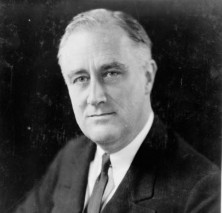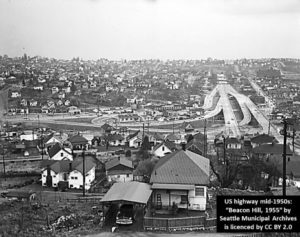Why the U.S. New Deal became the No Deal
J.D. Alt

U.S. progressivism needs to make a special effort, now, to re-kindle the vision of Franklin Roosevelt. The activist, direct government spending of Roosevelt’s New Deal pulled the U.S. from the depths of the Great Depression, mobilized the nation for a successful prosecution of World War II and, after the war, ushered in a decade of middle-class prosperity previously unimagined. Then something strange happened: A succession of American presidents and congressional administrations systematically began undoing everything FDR had put in place. This process culminated with the presidency of Donald Trump in which activist, direct government spending to address virtually any need of collective society (including basic public health initiatives in the face of a viral pandemic) was viewed by dominant U.S. conservatism as excessive – and unaffordable – government over-reach.
What is missing from this story is why Roosevelt’s New Deal was systematic- ally attacked and dismantled after the end of WW2. What motivated this about-face with regard to the New Deal’s economic model of direct government spending to pay U.S. citizens to build things they collectively benefited from, and provide services they collectively needed — a model that had demonstrably served the U.S. so well for the previous decade and a half? Answering this question, it seems to me, is crucial to any strategy for rekindling president Roosevelt’s vision — and for implementing the newly formed perspective of Modern Money Theory.
What the New Deal did, that had never been done before on such a grand scale, was to create government fiat- money to pay citizens to produce goods and services that private enterprise was unwilling, or unable, to provide. This put money in people’s pockets where previously there had been none, creating a purchasing power that subsequently supported the production of private goods and services. In the process of creating that purchasing power, the government’s spending programs also produced things that citizens directly benefited from: electric grids, roads, schools, hospitals, etc. This was the super-charged, double benefit of the New Deal. It was also the first implementation of the economic theory of the U.K. economist John Maynard Keynes, who had been arguing – unsuccessfully for just this kind of direct, activist, government spending for domestic benefit since the conclusion of World War I. Keynes’ failure to win that argument in Europe deepened the economic slide of the depression and led directly to the rise of fascism, Adolph Hitler, and the catastrophe of World War II. But the unique success of Keynes’ economic model in the U.S. was a shining light on what is possible.

After the triumph of the U.S. war mobilization, Keynesian economics was firmly established in the U.S. status quo.
President Eisenhower, for example, used direct government spending to build the U.S. interstate highway system — and the federal government continued, throughout those early post- war years, to pay for the college tuitions of tens of thousands of ex-American servicemen and women, an educational push that did more than anything else to create the new U.S. middle-class.
But there had always been a faction of U.S. society passionately opposed to Roosevelt’s vision — and the Keynesian economic model supporting it. That faction comprised the special interests and powerbrokers associated with Wall Street financing and the corporate state — people who feared that a continuation of the New Deal monetary model would lead, inevitably, to a “socialist” government (a condition in which the federal government, rather than private enterprise, would decide what investments should be made and what projects should be undertaken). And, more to the point, such a government would deprive the Wall Street financiers and corporate elite of the exclusive power their capital and profits had always exercised (until the interventions of the New Deal and World War II) over the U.S. economy and political agenda.
The attacks against the New Deal and Keynesian economics — underwritten and led by this powerful set of interest groups — began in the 1950’s with the fearmongering campaign of Senator Joseph McCarthy.
To make the fear more intense, the economic activism of “socialism” (more accurately described in this context as social democracy), which was conflated with the social controls of communism. The “socialism/communism” bogeyman was framed as an “un-American” form of government which denied the free- will and liberty of U.S. individualism — the founding ideals of the country.

Those who were – or had been – associated with direct government spending for the good of collective society were labeled as communist sympathizers.
The economists and managers who had ushered in the New Deal — and who organized and operated the U.S. economy during the mobilization and execution of WWII — were publicly dis- credited and also accused of being “Un-American” traitors or communist infiltrators.
Tellingly, after publicly decimating the “communist” Keynesian economic model (and those who supported it) in the name of the “free-will individualism” of private enterprise capitalism, this same faction of special interest power brokers, subtly transformed this same Keynesian monetary model into another kind of “New Deal” — this time for corporate America. That second “New Deal” is known as the military-industrial complex. Federal money created and disbursed to the corporate financiers of the military-industrial complex did not build infrastructure or produce goods and services for the American people — instead, it paid the corporate state to build and maintain an unchallengeable war machine to wage a “cold war” against communism.
This second “New Deal” proved what John Maynard Keynes, himself, had warned against: Keynesianism could empower governments to either carry out a program of good works for the collective well-being, or selfish things for an elite class heavily engaged in ruling, controlling, and manipulating the government’s purse strings. Keynesianism wasn’t disproven in the 1950’s, it was “secretly” hijacked by a ruthlessly selfish corporate/ financial oligarchy.
Each of the U.S. presidents thereafter — whether Democrat or Republican — aided, abetted, and empowered this oligarchy, either by actively supporting it or by passively refusing to rebut its narrative about the need to hold in check government activism for the collective good. Only one Democrat – Lyndon Johnson – briefly resurrected Keynesian strategies to create a third New Deal — this time, once again, for the U.S. people themselves. Johnson’s Great Society initiatives introduced Medicare, Medicaid, Food Stamps, Public Radio, and myriad other programs that enhanced life for millions of citizens. Ironically, Johnson’s efforts were cut short by his acquiescence to the nation’s continuing and compulsive fearmongering of communism (i.e. the Vietnam War).
It was, then, the nation’s obsessive fears of communism (and its conflating of communism and social democracy) — fears stoked and orchestrated by the financial and corporate power structure of private enterprise for its own enrichment — which enabled the repudiation of FDR’s vision. While the Vietnam tragedy and the end of the Cold War cooled the nation’s anti-communist fervour, the view of federal government activism as an encroachment on the free-will of private enterprise continued to be a burning ember that could be rekindled for each election cycle — and each federal budget debate — to hold in check any resurgence of New Deal sentiments (more recently, sentiments for universal healthcare and a “Green New Deal” to address climate change).
Taking this perspective, it would seem the specific and special task U.S. progressivism has today is two-fold:
De-conflate social democracy (activist, direct spending by the federal government to achieve collective goals) from communism (authoritarian, central control and management of the means of production) — making clear that the latter is something the progressive world should push back against at every opportunity, while the former constitutes a logical and effective partner for private enterprise itself.
Define a U.S. social democracy that specifically supports and enables the free-will individualism so central to America’s idealism. This messaging could be condensed into something like: “communism controls individuals – social democracy empowers them.”
Source: New Progressives, 1 Sept 2020
https://realprogressives.org/why-the-new-deal-became-the-no-deal/
Republished with the permission of the author.





























